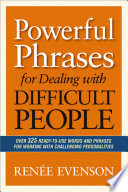

The first main idea of the book emphasizes the importance of recognizing and understanding the various types of difficult behavior we encounter in our personal and professional lives. The author categorizes difficult people into several archetypes, such as the 'Aggressor,' 'Know-it-all,' and 'Whiner.' Understanding these behaviors allows individuals to anticipate challenges and respond more effectively. This section dives into the psychological underpinnings of why people behave in certain ways, highlighting that often, difficult behavior stems from fear, insecurity, or past experiences. By understanding the motivations behind difficult behavior, readers can approach these interactions with empathy and clarity, rather than frustration and anger. The book provides specific phrases and strategies tailored to each type of difficult person, equipping readers with the tools they need to navigate these challenging dynamics.
Continue readingA significant portion of the book focuses on the power of language in shaping interactions. The author argues that the words we choose can either escalate a conflict or defuse it. By using powerful phrases and carefully crafted language, individuals can communicate their needs and boundaries without provoking defensiveness or hostility. The book offers practical examples of phrases that can be employed in various situations, illustrating how a slight change in wording can lead to vastly different outcomes. This section is particularly useful for individuals looking to improve their communication skills, as it emphasizes the importance of being intentional with language in order to foster understanding and cooperation.
Continue readingAnother critical idea presented in the book is the necessity of setting clear boundaries when dealing with difficult people. The author argues that many conflicts arise from blurred lines and unclear expectations. Readers are encouraged to define their limits and communicate them effectively, using specific phrases that assert their boundaries while remaining respectful. This section not only provides practical language for setting boundaries but also discusses the psychological benefits of doing so, such as reduced stress and increased self-esteem. By learning to assert their needs, readers can create healthier relationships and minimize the impact of difficult individuals on their lives.
Continue readingThe book also highlights the importance of active listening when dealing with difficult people. The author explains that many conflicts stem from misunderstandings and a lack of genuine communication. By employing active listening techniques, individuals can demonstrate empathy and validate the feelings of others, which can often diffuse tension. The book provides specific phrases that encourage open dialogue and show that the speaker is being heard, fostering a more collaborative atmosphere. This idea is crucial for anyone looking to improve their interpersonal skills, as it emphasizes the role of listening in resolving conflicts and building stronger relationships.
Continue readingThe author delves into the concept of emotional intelligence (EQ) and its significance in navigating difficult interactions. This section explains how understanding one's own emotions, as well as the emotions of others, can lead to more effective conflict resolution. The book provides strategies for enhancing EQ, including self-regulation, empathy, and social skills. By developing emotional intelligence, readers can better manage their reactions to difficult people and respond in a way that is constructive rather than reactive. This idea is particularly relevant for leaders and professionals who frequently encounter challenging dynamics in the workplace.
Continue readingMaintaining professionalism in the face of difficult behavior is another key theme in the book. The author discusses the importance of staying composed and respectful, even when provoked. This section provides readers with phrases and strategies for remaining professional, regardless of the circumstances. The book emphasizes that maintaining professionalism not only protects one's reputation but also sets a standard for the interaction. By modeling respectful behavior, individuals can influence the dynamics of the conversation and encourage more positive outcomes.
Continue readingFinally, the book discusses strategies for managing long-term relationships with difficult people. The author acknowledges that some individuals may be a permanent part of one's life, whether in a personal or professional capacity. This section offers guidance on how to maintain a healthy relationship over time, including regular check-ins, open communication, and the use of powerful phrases to navigate ongoing challenges. By applying these strategies, readers can create a more sustainable approach to dealing with difficult individuals, ultimately leading to more harmonious interactions.
Continue reading